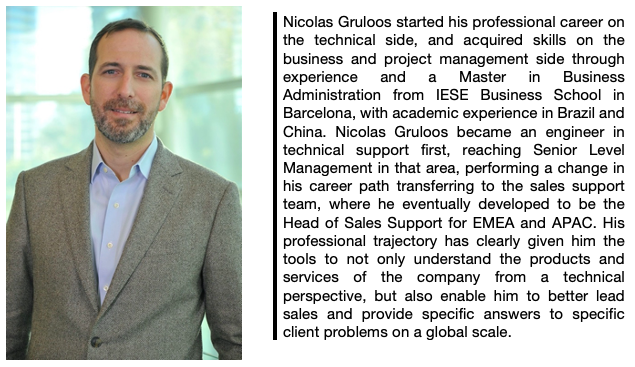At Q7 Consulting, we are aware that we live in times of uncertainty, and now more than ever Change Management and Leadership within organizations, are essential concepts for success.
We have decided to add to our blog a new series: interviews we have personally done to industry leaders, business managers, chief officers and entrepreneurs from all kinds of professional backgrounds and industries, getting their perspectives on how they managed and implemented Change in their organizations and throughout their professional careers. Giving us and providing you with some of their successes, their insights and their learnings attained throughout their professional life, on change management and leadership.
The people we interview are from all around the world, have outstanding professional trajectories, have attained success within their roles, have essential leadership traits, are influential within their organizations and have experience implementing and managing change. In this first episode of our new series, we interview Nicolas Gruloos, current Head of Sales Support at Kofax for Europe, Middle-East, Africa, and Asia-Pacific operations. Kofax is a Computer Software company with presence in over 60 countries around the world. Kofax’s Intelligent Automation software platform helps organizations transform information-intensive business processes, reduce manual work and errors, minimize costs, and improve customer engagement.

Please find below the main questions addressed in our interview with Nicolas Gruloos, with to the point answers for easy reading.
What have been your takeaways from managing Change?
Managing change requires managing the emotions of each stakeholder at every level. Change is highly emotional for people, they need to adapt to a new situation. When you bring change over change, the employees are outside of their comfort zone, and they never asked for that. You need a good sense of emotional intelligence, empathy, and to always keep in mind the business objective of the change.
What is your advice to people who start managing major changes in organizations for the first time?
When you start you cannot position yourself as the expert, you will not be trusted. The best way to gain trust is to “get your hands dirty”: do the things that you expect others to do, the systems and processes. Don’t promise anything yet, you are not knowledgeable enough to make any promises. You will hear the pain of others, and at that time, it is important to listen and to manage expectations.
What was your role in making changes in the organization, and were the changes clearly linked to the mission and vision of the company?
Three years ago, when I started in my present role, we wanted to unify the sales support operations into a globally consistent team. My role consisted – and still is – to bring everyone together, and to make sure that we all work the same way.
You know, we sell a platform to enable our customers to work more efficiently, and this is, in most changes, the ultimate intention as well. Enabling employees to work better and grow within the company, is perfectly aligned with our vision.
How did your company support you in getting ready to lead / manage Change?
It was when I switched to working in the Professional Services Centre of Excellence, 12 years ago, that I started to gain huge experience in leading and managing change, the management team thought that I was good at this and supported me in getting trained and certified on all major frameworks (ITIL, Prince 2, PMI PMP). To give it even a better basis I followed a Master in IT Management which was intensively around Project Management for IT organizations. My company allowed some flexibility to attend the courses on some evenings and weekends. I must admit that I’ve been lucky to have great mentors that helped to develop my leadership and management skills.
What strategies worked and did not work to communicate the changes, and what strategy did you use to generate a sense of urgency with people?
When I was in the customer service organization, I learned the Knowledge Centered Service (KCS), a concept that consists in providing answers through articles. So instead of providing a straight response by email, I’m writing an article and I provide the link to it. We now have a global knowledge base of articles and procedures made of all type of questions coming to our organization. When a procedure changes or requires clarification, I just edit the article and share the update with the link. This strategy has been successful to communicate changes.
What hasn’t worked in communicating changes, is doing so through email. The worse you can do is to communicate changes through emails, because people receive too many emails, and people do not read emails that easily. I have also tried videos, but the thing with videos is that they are more time consuming than articles, and if you want to modify the videos, it takes much more time to do so, contrary to articles.
My strategy to generate a sense of urgency with people, related to change management, is to have them contributing to the change and make the success their success.
How did you approach planning changes? How well were the change plans followed and how did you approach changes to the plans?
There’s different models and tools to do that. The first thing you will try is using an Excel file, but you rapidly lose track, because there aren’t enough mechanisms to prevent and control changes, to report or share information. My answer and recent discovery is DevOps, which is relatively new. With DevOps I can have all the lists of stories, issues, tasks that are related to the changes that I want to drive, and all the stakeholders have access, they can easily create reports, automate sharing of information, and integrate into communication streams such as Microsoft Teams and other. I don’t need to spend time sending emails, because when I modify a field, it notifies the group of people that want to see information about this project, or this group can view a report with the up to date status, plus they have access to the level of detail they want. Of course, executive summary emails still require some manual effort, but you get all the information you need for that in one go.
There is no project that goes as expected, there are always surprises. You need to be very constructive, it is all about understanding the impact that this change on change will have. What if we delay the change by two or three weeks? How will it impact the business? Will some users be upset or complain? Will we still be able to move resources that we previously allocated? Keeping calm and remaining respectful, understanding how we will get there without blaming.
What strategies did you use to attain milestones and make achievements visible?
I think it’s all about having a clear vision as to where you need to go, so you need to define clear milestones and SMART objectives. If the objectives are not achievable it will destroy your reputation. Negotiating the milestones with higher management will be the key to success.
Visibility is achieved through success, which helps continuing with Change. If there is no success, the team will not want to pursue the Change.
What did you do to keep people committed? What did you do to keep people from going back to old ways?
An essential element is to hear from them, communicate that the change simplifies the way they work, it makes them work faster and allows them to do more things in less time.
About keeping people from going back to the old ways, on one hand if the old way is absolutely not possible to do anymore, for example because the system has been changed, then obviously there is no way back. But if the old way is still possible, then it is just about making sure everybody understands the benefit of using the new way. It’s the role of the change leader to ask the employee why they’re still using the old way and hear if there’s something that might have been missed in the new way. We need to be very sensitive to these situations, I would not force employees to work the new way, but rather make sure they known that there is another way which might allow them to work better and more efficiently. If it is not harmful, then we can always let the employee use the old way, they might be right, and you might be wrong. If you force things it can be harmful to the relationship with the employees and the company.
Did you underestimate or overestimate what was needed to be done to achieve change?
If you follow a good framework, you don’t need to ask yourself that question. Make sure you regularly check the successes, and do not worry if you underestimated or overestimated what needed to be done to get there.
What worked in planning and executing changes?
I have learned that during the planning phase of a change, it’s good to work with all the different impacted business units to discuss about the plan, the transition, and eventually agree together on validating the change requirements. What worked during the execution, is not to deploy everything at once, try on a small group first to see if the Change is easy to adopt and makes a difference.
We hope the insights acquired through this interview to Nicolas Gruloos has made you reflect on Change Management, Change Leadership and the experience acquired from an experienced manager leading from an international company, driving digital transformation and efficiency within organizations.
